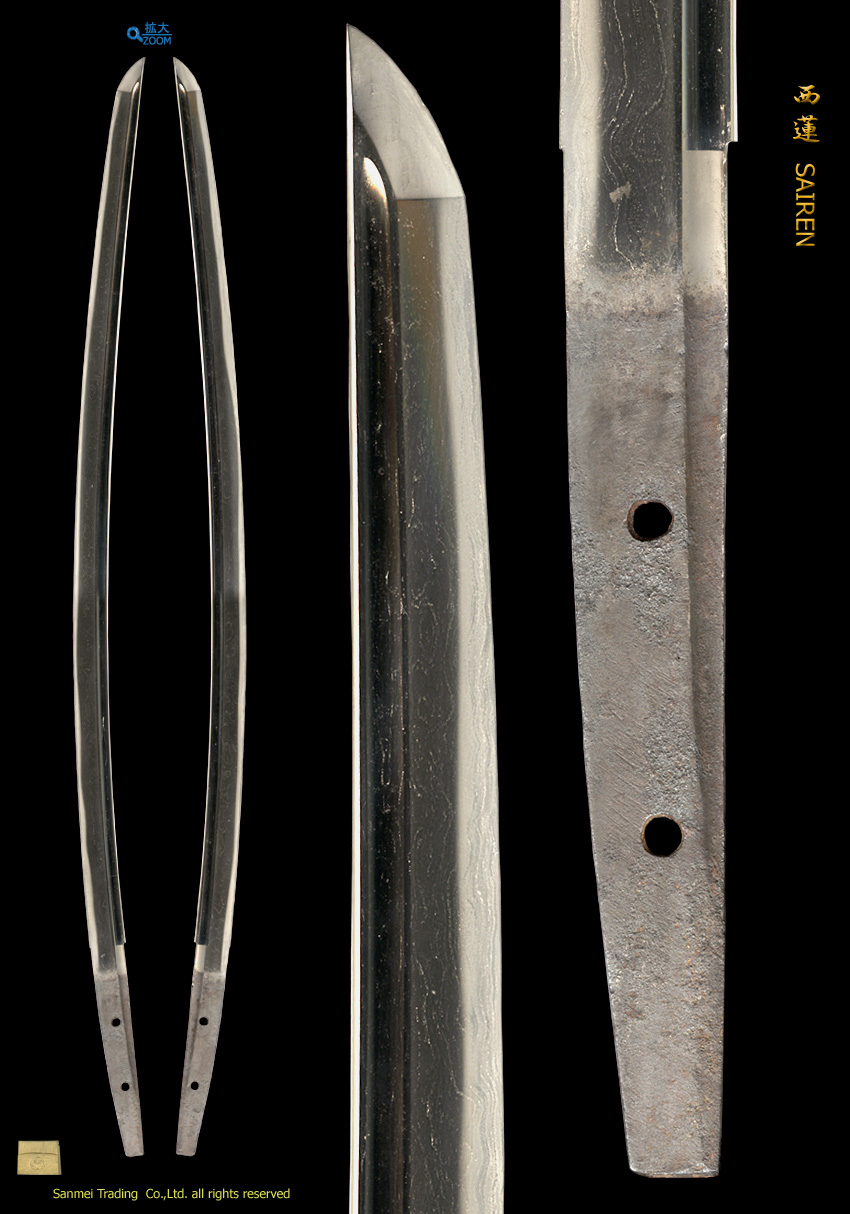Length of cutting edge67.4cm Curvature2.0cm Width of base27.9mm Thickness of base6.0mm Width of Yokote18.0mm
Forging(Hada): Forging is Itame base, mixing with Mokume burl, large Itame wooden grain mark and streaming indication. The entire forging appears conspicuously visible and it's surface is deeply covered in sparkling ji-nie glitter that generates darkish Nie lines grain so called CHIKEI activity. The entire forging scene is full of classical grace.
Temper(Hamon): Hamon is rather strong side but soft Nie hard metal granules based, Notare wavy mixing with small and irregular "Gunome", "Hotsure-ha" fray and double or triple thick lines of Nie appears, where entire quench is covered with thick sparkling Nie glitter. The interior of temper is filled with mist-like crystallize area deeply with thick lines of Nie SUNAGASHI or KINSUJI frequently appears. The entire quench scene is a bit dim in the soft and soaked hard metal granules of Nie with deep Nioi area.
Temper of tip(Boshi): Quench of Boshi is frequent Hakikake indication, "Yakizume" end in front and the reversed side is straight up with sharpened up indication with small circle turns back.
Tang(Nakago): Nakago is substantially shortened so called "Ō-suriage" unsigned. Two peg holes. Kiri (horizontal) filemarks. Back ridge of Nakago is flat and Kiri (horizontal) heel shape. The age of "Ō-suriage" would be judged early Edd 17th century.
Fukuoka and Saga prefecture in Northwest Kyushu area faces Genkainada channel to the the Korean Peninsula and continental Asia between East Sea and Yellow Sea. The area has been one of the the major places for foreign trading, diplomacy and national defense as well. 太宰府 Dazaifu (government) established for the regional government in Kyushu from the 8th to the 12th centuries. The town of Dazaifu grew up around the civil and military headquarters of the regional government.
During the Medieval period in northwest Kyushu area, there were two major lineages of 左文字 Samonji and 金剛兵衛系 Kongobei.
The celebrated lineage of 左文字 Samonji was founded 良西 Ryosai - 入西 Nyusai - 西蓮 Sairen - 実阿 Jitsua - 左文字 Samonji who were Buddhist priests under the patronage of 善導寺 Zendouji temple.
西蓮 Sairen who is a son of 良西 Ryosai, an elder brother of 入西 Nyusai, initially named himself 国吉 Kuniyoshi then changed 西蓮 Sairen of Buddhist monk's name. He worked for 鎮西談議所 Chinzei Dangisho (a court of justice/town office) where belonged to 善導寺 Zendouji temple. For that days and ages, there were major military efforts the Mongol invasions of Japan (元寇 Genkō) of 1274 and 1281 undertaken by Kublai Khan and there were considerable large number of demands from the Samurai worriers.
The subject Katana was substantially shortened in the early Edo period, upholds the tradition of ancient Yamato school with fine steel that holds rather soaked and classical impression and forging scene indicates conspicuous Mokume, Itame and flowing Masame ware to say that "Full of Pastoral Beauty" which is the major character of ancient Koto blade in Kyushu. The judgement of 西蓮 SAIREN is surely appropriate under such major character of superb workmanship.
This sword is also reported on the book of Honma Junji, KANTO HIBISHO ZOKU, Otsuka Kogeisha 1969 and is awarded with the prize of 26th JUYO TOKEN 1979.
Aoi crest double layer habaki collar (lower layer is silver ground/gold foiled, upper layer is pure gold), Preserved in Shira-Saya plain wood mounting.
An old good polish/Condition scale: excellent-very good (using a scale of mint-excellent-very good-good-fair-poor).
reference data:
Honma Junji/Satou Kanichi, NIHONTO TAIKAN KOTO-HEN 3 Otsuka Kogei sha, 1969
Honma Junji, KANTO HIBISHO ZOKU, Otsuka Kogeisha 1969

